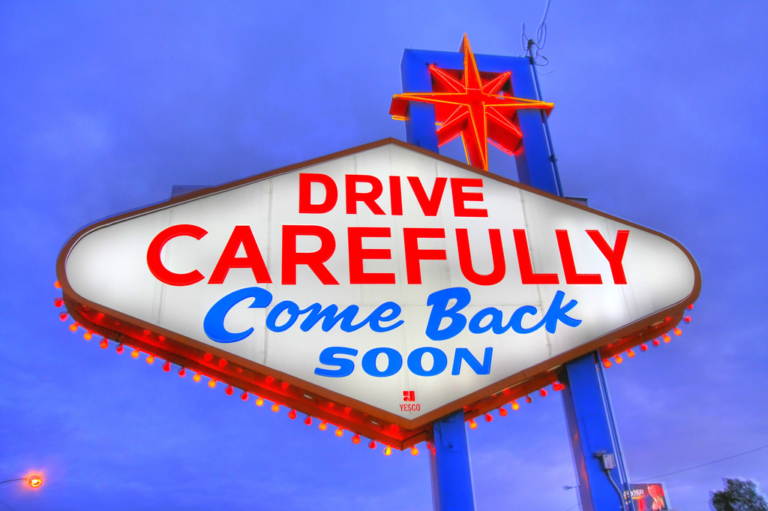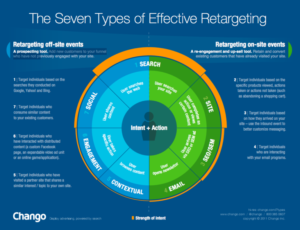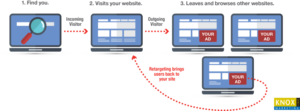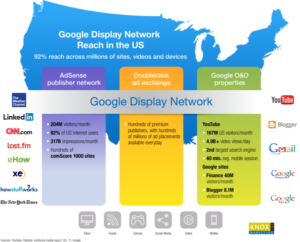
You spent a lot of time, energy, and money on your website. It’s a lynchpin piece of your brand and marketing – the place people go to determine if you’re a legitimate business, or if you provide the products or services they need. It’s listed on all your advertising and collateral. Your website helps you build trust, get listed on search engines, share news. It’s kind of a big deal.
Your Website’s Dirty Secret
Here’s something you need to know about your website: 96% of people who visit a website leave without completing the action you want them to take. Maybe you wanted them to download a guide, or fill out a form – or even just view a specific page.
Most of the time they just don’t do it.
When you consider that it can take more than 7 ‘touches’ with a prospect to turn them into a customer, you need a plan to bring them back to your web-site.
The first thing you have to recognize is that your web site’s abandonment rate is not personal. We’ve all done it – we visit a site, we get some information. Maybe we even bookmark it. And then we never come back again. NEVER.
Even if we have the best of intentions, life can just get in the way.
You have to remind the prospect who you are, and why they should come back.
Retargeting Puts You Back In Front of Past Visitors
Technically speaking retargeting uses a piece of code (sometimes called a tag or a pixel) to place a cookie into a visitor’s browser. This way you know who’s been to your website – you can even record when they visited, and what pages they saw.
Once you have that cookie in their browser, your retargeting ads can follow these visitors: on Facebook, in Google Search, or even through display ads in their general web surfing activity through the Google Display Network.
Their are over two million sites in the Google Display Network, including highly trafficked brand name sites, and even popular Google sites, like YouTube and Gmail. It even includes AdMob for mobile targeting in apps.
This keeps you in front of the prospect, and helps you:
- Turn past website visitors into repeat visitors, and leads.
- Increase brand recall, and brand-based searches
- Increase repeat visitor rates
How well does it work?
- Retargeting can boost ad response up to 400 percent.
- Web site visitors who are retargeted with display ads are 70 percent more likely to convert on your Web site
- On average, retargeting ads show a 10x increase in click-through rates (CTR), since people can already relate to your ad.
Chango has created a great infographic showing the different ways you can retarget based on off-site and on-site events.

(Image source: Chango)
For now, let’s just consider the remarketing opportunity with people who have visited your site.
Here’s the awesome thing…
The first time they came you were a stranger, now you’re a familiar name.
When presented with your retargeted message you don’t have to start all the way back at ‘square one.’ You don’t even have to take people to your web site’s home page. You can craft your ad’s for the best next step you want them to take.
Better yet, you can craft your ad for the best next step THEY want to take.
Maybe the first time someone found you they came to your site through an organic Google Search Result. But for one reason or another, even after pricing numerous trips to Florida, they never booked a trip. Remarketing your specials for trips to Florida would be the ideal message to reach this audience, instead of a generic brand messages or ‘travel service’ ads.
Once you know what they are looking for you can target your audience with offers and images that match their most logical next step – like this ad from Expedia using eye-catching imagery to re-engage travel deal seekers.
Maybe you provide professional services and they read about an important free guide you offer on your website, but never downloaded it. Use retargeting to put that specific offer back in front of them and give them a reason to come back and download it.
Not everyone coming to your site is a first time visitor. Retargeting allows you to speak to prospects about their specific experience with your brand.
How to Retarget Without Being Creepy
Early studies about consumer response to remarketing showed that once an ad is seen up to five times it becomes “annoying”, or “intrusive.” According to a study by InSkin, once someone see that ad 10 times, the response can turn to “anger.”
However, the same study showed that 53% of the respondents said ads from a relevant company are useful when initially researching a product or service. In this case, people are four times as likely to be encouraged to make a purchase.
Other studies have shown that the clickthrough rate of remarketing ads stays higher than ‘cold’ ads. This is true even after ad fatigue. After having seen an ad six times, a user is still more likely to click on a remarketing ad than a brand new display ad.
Still, how do you encourage engagement without over-marketing and making people angry?
Understand Your Customer and Your Business Objective
How often people need to see your ads depend on the natural flow of your sales cycles. Are you selling high end services or expensive jewelry, and customers typically have a long time between purchases/conversions? In that case you don’t need to be retargeting them aggressively post-conversion, and will want to time your exposure appropriately to keep your brand in front of them occasionally over a longer timeframe.
However, if your business thrives on repeat customers – like a sub shop, or a pizza parlor, where customers could order multiple times in one week, you can be more aggressive with how often people see your ad.
Depending on the network you’re using, you can control these through a few retargeting campaign settings:
Duration – How long you want to remarket to someone
Duration is how long you store a cookie and target a visitor. If you are promoting a special offer, or an event, with a specific end date you would want to stop remarketing to people who visited your offer or event page.
If you sell highly-priced goods or services, which involve a longer sales cycle, a longer time frame – even up to 180 days could be appropriate.
Frequency Capping – How many times someone will see your ads
As the study mentioned above makes clear, there is a fine line between ad exposure being useful and annoying.
Yes – some people might notice you’re remarketing to them – ‘following them’ around on the interest. This is usually a side effect of having a very small audience, and setting no frequency cap. The result is you don’t have enough audience members to spread your ad impressions across and your ads appear EVERYWHERE.
Frequency capping allows you to limit how often a user will see your remarketed ad.
Conversion-Based Segmentation
Few things annoy people more than being remarketed to for something they’ve already viewed, purchased, downloaded, or even an event for which they’ve completed registration. Fortunately, it’s easy to remove converted users from a retargeting campaign.
This gives your user a better brand experience, and makes better use of your campaign budget.
Give It a Try
Remarketing allows you to focus on people who have already engaged with your brand, target them with messages specific to their place in your marketing funnel, and studies show it typically produces higher engagement and conversions.
It’s a powerful component of any media strategy when used properly. There’s no reason to wait even one day before planning your remarketing strategy and making the most of your website visitors.
Image attribution (in order of appearance in this post):
By AI R – Las Vegas, CC BY-SA 2.0, https://www.flickr.com/photos/123chromapixels/4322581745/










